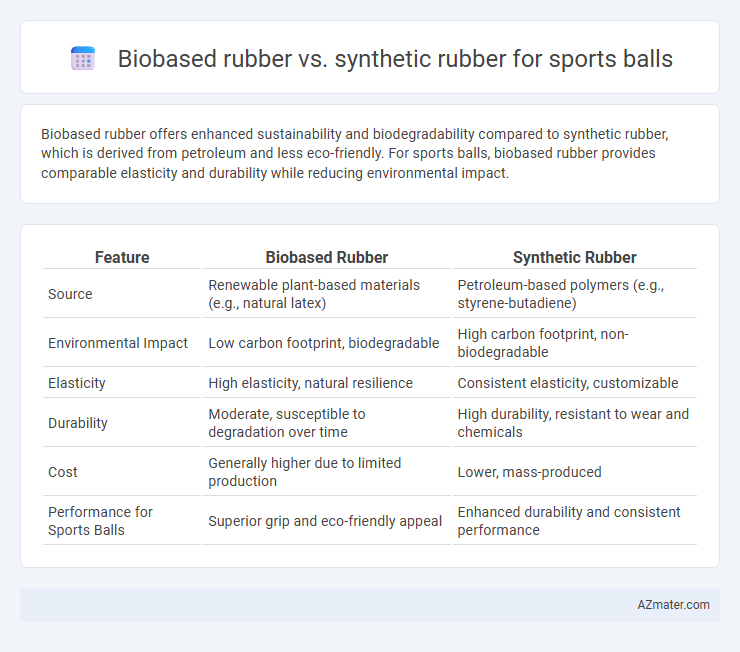Biobased rubber offers enhanced sustainability and biodegradability compared to synthetic rubber, which is derived from petroleum and less eco-friendly. For sports balls, biobased rubber provides comparable elasticity and durability while reducing environmental impact.
Table of Comparison
| Feature | Biobased Rubber | Synthetic Rubber |
|---|---|---|
| Source | Renewable plant-based materials (e.g., natural latex) | Petroleum-based polymers (e.g., styrene-butadiene) |
| Environmental Impact | Low carbon footprint, biodegradable | High carbon footprint, non-biodegradable |
| Elasticity | High elasticity, natural resilience | Consistent elasticity, customizable |
| Durability | Moderate, susceptible to degradation over time | High durability, resistant to wear and chemicals |
| Cost | Generally higher due to limited production | Lower, mass-produced |
| Performance for Sports Balls | Superior grip and eco-friendly appeal | Enhanced durability and consistent performance |
Introduction to Sports Ball Materials
Sports balls primarily use rubber materials to balance durability, elasticity, and performance. Biobased rubber, derived from renewable natural sources like guayule or dandelions, offers eco-friendly alternatives with comparable elasticity and resilience to traditional synthetic rubber, which is petroleum-based and engineered for consistent quality. Material choice impacts ball weight, bounce, and environmental footprint, making biobased rubber increasingly relevant for sustainable sports equipment manufacturing.
Overview of Biobased Rubber
Biobased rubber, derived from renewable natural sources such as the guayule plant and dandelion roots, offers an eco-friendly alternative to synthetic rubber in sports ball manufacturing. It features comparable elasticity, durability, and resilience while significantly reducing carbon footprint and reliance on petroleum-based materials. Innovations in biobased rubber technology continue to enhance performance characteristics, making it a sustainable choice that meets industry standards for high-quality sports equipment.
Overview of Synthetic Rubber
Synthetic rubber, primarily derived from petrochemical sources such as styrene-butadiene and polybutadiene, dominates the sports ball industry due to its superior durability, elasticity, and resistance to abrasion. Its consistent physical properties enhance ball performance, including bounce resilience and surface grip, essential for accurate gameplay. Despite environmental concerns, ongoing innovations aim to improve synthetic rubber's recyclability and reduce its carbon footprint in sports equipment manufacturing.
Environmental Impact Comparison
Biobased rubber for sports balls significantly reduces carbon emissions compared to synthetic rubber, as it is derived from renewable natural resources like Hevea brasiliensis sap. Unlike synthetic rubber, which relies heavily on petroleum-based raw materials and energy-intensive production processes, biobased rubber offers enhanced biodegradability and decreases reliance on fossil fuels. Its lower ecological footprint spans reduced greenhouse gas emissions, diminished pollution, and decreased chemical waste, making it a more sustainable option for manufacturing sports equipment.
Performance Characteristics in Sports Balls
Biobased rubber in sports balls offers enhanced eco-friendly elasticity and resilience, providing superior grip and shock absorption compared to traditional synthetic rubber. Synthetic rubber often delivers consistent durability and resistance to abrasion, ensuring prolonged performance under extreme play conditions. The choice between biobased and synthetic rubber impacts ball bounce, control, and overall player experience, with biobased variants increasingly optimized for high-performance sports applications.
Durability and Longevity
Biobased rubber used in sports balls offers enhanced environmental sustainability while maintaining competitive durability due to its natural polymer structure, which resists abrasion and maintains elasticity over time. Synthetic rubber, commonly made from styrene-butadiene or polybutadiene, provides superior resistance to extreme temperatures and UV exposure, contributing to longer lifespan under intensive use. Studies indicate biobased rubber matches synthetic alternatives in maintaining bounce and shape retention, with ongoing advancements improving its wear resistance for extended longevity.
Cost Efficiency and Market Availability
Biobased rubber for sports balls offers growing cost efficiency due to advancements in sustainable material production, though it currently tends to be more expensive than synthetic rubber. Synthetic rubber dominates the market availability with widespread manufacturing infrastructure and consistent supply chains, ensuring lower prices and high-volume production. As consumer demand for eco-friendly products increases, biobased rubber is expected to gain competitive cost advantages and market presence over time.
Safety and Health Considerations
Biobased rubber for sports balls offers enhanced safety due to its natural origin, reducing exposure to toxic chemicals and allergens commonly found in synthetic rubber. Synthetic rubber, though durable, may contain additives like heavy metals and volatile organic compounds that pose health risks during prolonged contact or intense play. Choosing biobased rubber improves player safety by minimizing harmful chemical exposure and supporting skin-friendly, non-toxic sports equipment.
Innovation and Future Trends
Biobased rubber for sports balls is advancing through innovative use of renewable resources like guayule and dandelion rubber, enhancing sustainability without compromising performance. Emerging technologies focus on improving the elasticity, resilience, and durability of biobased materials to rival traditional synthetic rubbers, which are commonly derived from petrochemicals such as styrene-butadiene and polybutadiene. Future trends indicate a growing shift towards hybrid formulations combining biobased and synthetic components to optimize eco-friendliness, cost-efficiency, and high-performance standards in sports ball manufacturing.
Conclusion: Choosing the Right Rubber for Sports Balls
Biobased rubber offers environmental advantages such as biodegradability and reduced carbon footprint, making it a sustainable choice for sports balls. Synthetic rubber provides superior durability, consistency, and performance under diverse weather conditions, which is crucial for professional sports equipment. Selecting the right rubber depends on balancing eco-friendliness with the required performance standards for the specific sport and playing conditions.

Infographic: Biobased rubber vs Synthetic rubber for Sports ball
 azmater.com
azmater.com